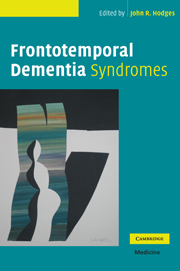Book contents
- Frontmatter
- Contents
- List of contributors page
- Preface
- 1 Overview of frontotemporal dementia
- 2 Epidemiology of frontotemporal dementia
- 3 Clinical presentations of frontotemporal dementia
- 4 Overlap syndromes
- 5 The neuropsychology of frontotemporal dementia
- 6 Neuroimaging and other investigative findings
- 7 The histopathology of frontotemporal dementia
- 8 Molecular neuropathology in familial and sporadic frontotemporal dementia
- 9 The genetics of frontotemporal dementia
- 10 Psychological interventions in frontotemporal dementia
- Index
2 - Epidemiology of frontotemporal dementia
Published online by Cambridge University Press: 05 August 2016
- Frontmatter
- Contents
- List of contributors page
- Preface
- 1 Overview of frontotemporal dementia
- 2 Epidemiology of frontotemporal dementia
- 3 Clinical presentations of frontotemporal dementia
- 4 Overlap syndromes
- 5 The neuropsychology of frontotemporal dementia
- 6 Neuroimaging and other investigative findings
- 7 The histopathology of frontotemporal dementia
- 8 Molecular neuropathology in familial and sporadic frontotemporal dementia
- 9 The genetics of frontotemporal dementia
- 10 Psychological interventions in frontotemporal dementia
- Index
Summary
Introduction
Until relatively recently, frontotemporal dementia (FTD) was believed by many to be (i) a rare disorder and (ii) clinically indistinguishable in life from other degenerative causes of dementia such as Alzheimer's disease (AD). Therefore, early work on the epidemiology of FTD relied almost entirely on autopsy data from specialised centres. With the publication, however, of consensus diagnostic criteria for FTD from the Lund and Manchester groups (Brun, 1994; Neary et al., 1998) it has been established that patients with FTD may in fact be diagnosed in life with relative confidence (Lopez et al., 1999). More accurate clinical diagnosis of FTD has led in turn to a number of valuable clinical case series and, more recently, large-scale community-based studies. This chapter will summarise the findings of the major pathological, clinic-based and community-based epidemiological studies of FTD to date, aiming to cover the incidence, prevalence, geographical variation, range of presentations, age at onset, sex ratio, prognosis, genetic contribution and other risk factors for this disorder.
Pathological studies
One of the first systematic pathological studies of FTD examined the brains of 158 patients diagnosed with dementia and found changes of FTD in 20 (13%) (Brun, 1987). Other clinic-based pathological series have found even higher proportions: for example, of the first 169 patients to come to post-mortem from the Addenbrooke's memory and early-onset dementia clinics between 1992 and 2005, FTD was diagnosed in over 30% (see Table 2.1).
All such studies from specialist units, however, suffer from a problem of recruitment bias. The higher frequency of FTD in the Cambridge series most likely reflects local interest in the pathology of early-onset disorders of behaviour and language rather than necessarily a higher local incidence of this condition, and community-based pathological series have found much smaller proportions of patients with FTD. For example, in a study of patients with dementia from the Twin Cities, Minnesota, FTD was diagnosed in only 6% of cases (Knopman et al., 1990). Similar results were obtained in a series of 382 patients with dementia from Florida, where participants were recruited to the brain bank from memory clinics throughout Florida and directly from the community through leafleting and talks to carers and support groups (Barker et al., 2002). Here, FTD was diagnosed in 21 cases (5%), while AD was diagnosed in 293 (77%).
- Type
- Chapter
- Information
- Frontotemporal Dementia Syndromes , pp. 25 - 37Publisher: Cambridge University PressPrint publication year: 2007
- 2
- Cited by



